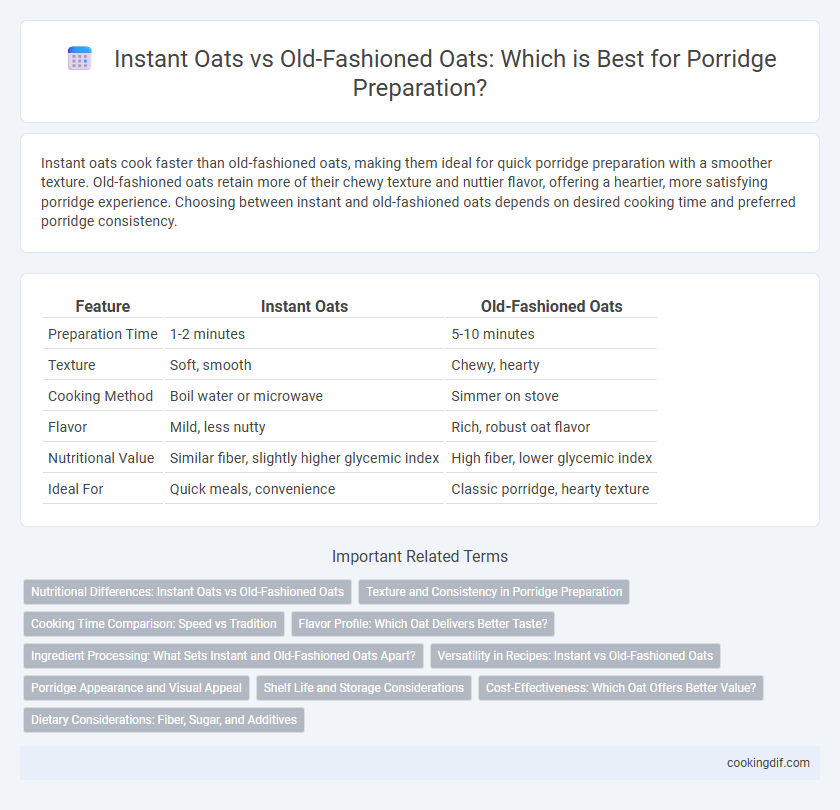Instant oats cook faster than old-fashioned oats, making them ideal for quick porridge preparation with a smoother texture. Old-fashioned oats retain more of their chewy texture and nuttier flavor, offering a heartier, more satisfying porridge experience. Choosing between instant and old-fashioned oats depends on desired cooking time and preferred porridge consistency.
Table of Comparison
| Feature | Instant Oats | Old-Fashioned Oats |
|---|---|---|
| Preparation Time | 1-2 minutes | 5-10 minutes |
| Texture | Soft, smooth | Chewy, hearty |
| Cooking Method | Boil water or microwave | Simmer on stove |
| Flavor | Mild, less nutty | Rich, robust oat flavor |
| Nutritional Value | Similar fiber, slightly higher glycemic index | High fiber, lower glycemic index |
| Ideal For | Quick meals, convenience | Classic porridge, hearty texture |
Nutritional Differences: Instant Oats vs Old-Fashioned Oats
Instant oats undergo more processing than old-fashioned oats, resulting in a finer texture and quicker cooking time but often higher glycemic index levels, which can cause faster blood sugar spikes. Old-fashioned oats retain more of their natural oat bran and fiber content, providing greater satiety and a slower, steadier release of energy. Nutritionally, old-fashioned oats typically offer more protein and vitamins like thiamine and magnesium, making them a healthier option for porridge preparation.
Texture and Consistency in Porridge Preparation
Instant oats create a smoother and creamier porridge texture due to their finer processing and quicker cooking time, making them ideal for a quick, uniform consistency. Old-fashioned oats, with their larger, flatter flakes, yield a heartier, chewier porridge that retains more bite and structure after cooking. Choosing between the two depends on whether a creamy or textured porridge is preferred, influencing the overall mouthfeel and consistency of the final dish.
Cooking Time Comparison: Speed vs Tradition
Instant oats cook in 1 to 2 minutes due to their finely processed texture, making them ideal for quick porridge preparation. Old-fashioned oats require 5 to 10 minutes of cooking, preserving the chewy texture and robust flavor preferred in traditional porridge. Selecting between instant and old-fashioned oats balances the trade-off between speedy preparation and the richer taste and texture of classic porridge.
Flavor Profile: Which Oat Delivers Better Taste?
Instant oats offer a milder, less textured flavor due to their finely processed nature, making them ideal for smooth, creamy porridge. Old-fashioned oats retain more of the oat's natural nuttiness and provide a chewier texture, enhancing the overall taste complexity. For richer, more robust porridge flavor, old-fashioned oats generally deliver better taste than instant oats.
Ingredient Processing: What Sets Instant and Old-Fashioned Oats Apart?
Instant oats undergo extensive processing, including steaming, rolling thinner, and pre-cooking, which results in a finer texture that cooks rapidly, ideal for quick porridge preparation. Old-fashioned oats are steamed and rolled but retain a thicker, denser flake, providing a chewier texture and longer cooking time that enhances the hearty consistency desired in traditional porridge. The difference in processing directly impacts the cooking duration, texture, and final flavor profile of the porridge.
Versatility in Recipes: Instant vs Old-Fashioned Oats
Instant oats offer quick preparation and a smooth texture, making them ideal for immediate porridge but less suited for recipes requiring structural integrity. Old-fashioned oats maintain their shape and provide a chewier texture, enhancing versatility in porridges, baked goods, and savory dishes. Their ability to absorb liquids slowly allows for diverse culinary applications beyond traditional porridge.
Porridge Appearance and Visual Appeal
Instant oats produce a smoother, creamier porridge with a uniform texture and pale color, appealing to those who prefer a soft, consistent appearance. Old-fashioned oats create a thicker, chunky porridge with visible oat flakes and a more rustic, hearty look, enhancing the visual appeal for traditional porridge lovers. The choice impacts the overall mouthfeel and presentation, with instant oats offering a sleek finish and old-fashioned oats providing a wholesome, textured appearance.
Shelf Life and Storage Considerations
Instant oats have a shorter shelf life, typically around 1 to 2 years, due to their pre-cooked and processed nature, requiring storage in a cool, dry place to maintain freshness. Old-fashioned oats maintain a longer shelf life, often up to 2 years or more when stored in an airtight container away from moisture and heat, preserving their natural texture and flavor. Proper storage in airtight containers with moisture absorbers helps extend the freshness and quality of both oat types for porridge preparation.
Cost-Effectiveness: Which Oat Offers Better Value?
Instant oats generally cost more per serving than old-fashioned oats, making old-fashioned oats the more budget-friendly option for porridge preparation. Old-fashioned oats provide larger quantities and longer shelf life, which enhances their overall cost-effectiveness. Choosing old-fashioned oats can significantly reduce spending while delivering a hearty and nutritious porridge experience.
Dietary Considerations: Fiber, Sugar, and Additives
Instant oats contain slightly less fiber than old-fashioned oats due to their finer processing, which also causes them to have a higher glycemic index, potentially impacting blood sugar levels. Many instant oat varieties include added sugars, flavorings, and preservatives, whereas old-fashioned oats are typically free from additives, making them a cleaner dietary choice. For those prioritizing fiber intake and minimal additives in porridge preparation, old-fashioned oats offer a more nutritious and controlled option.
Instant oats vs Old-fashioned oats for porridge preparation Infographic

 cookingdif.com
cookingdif.com